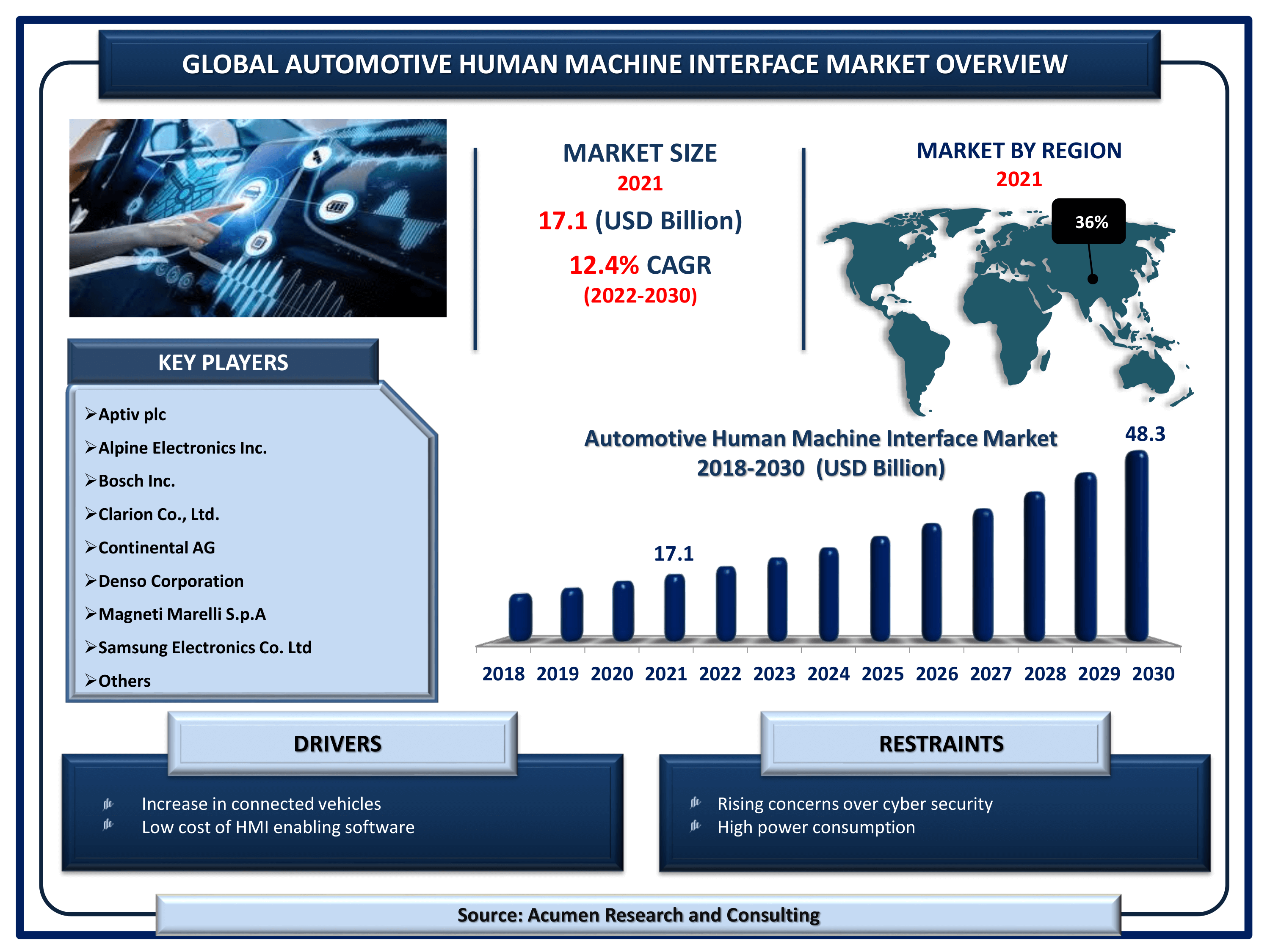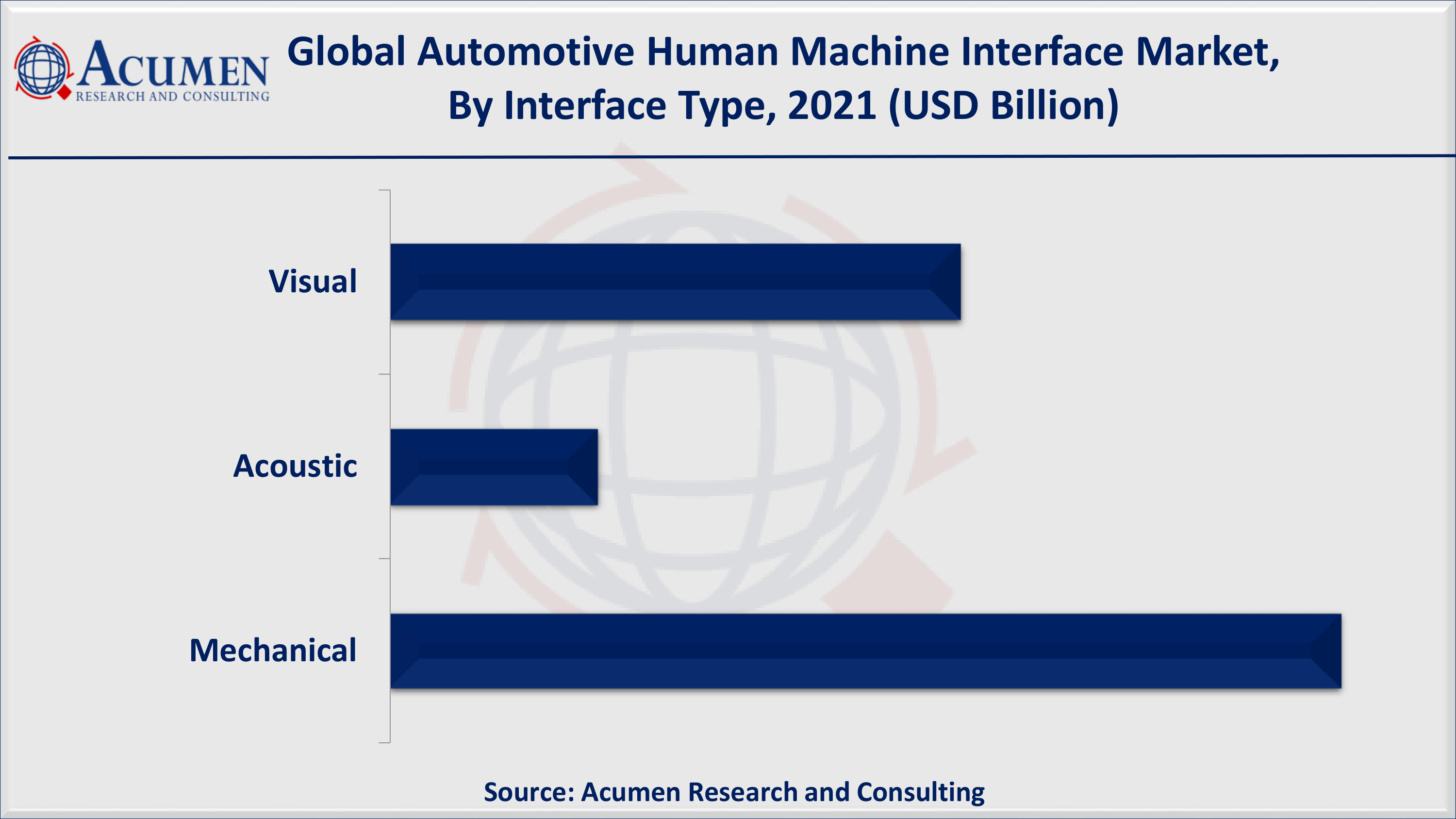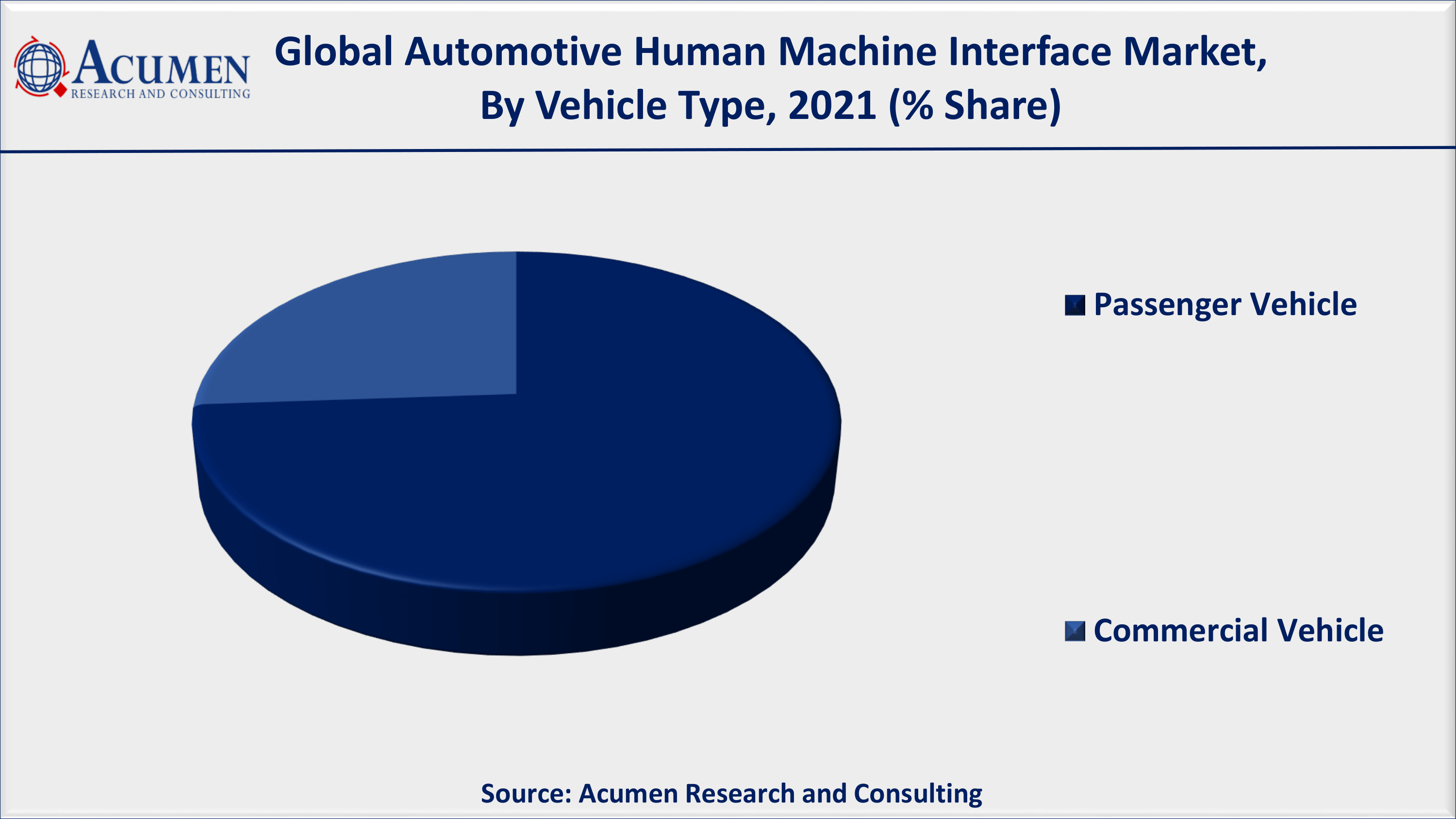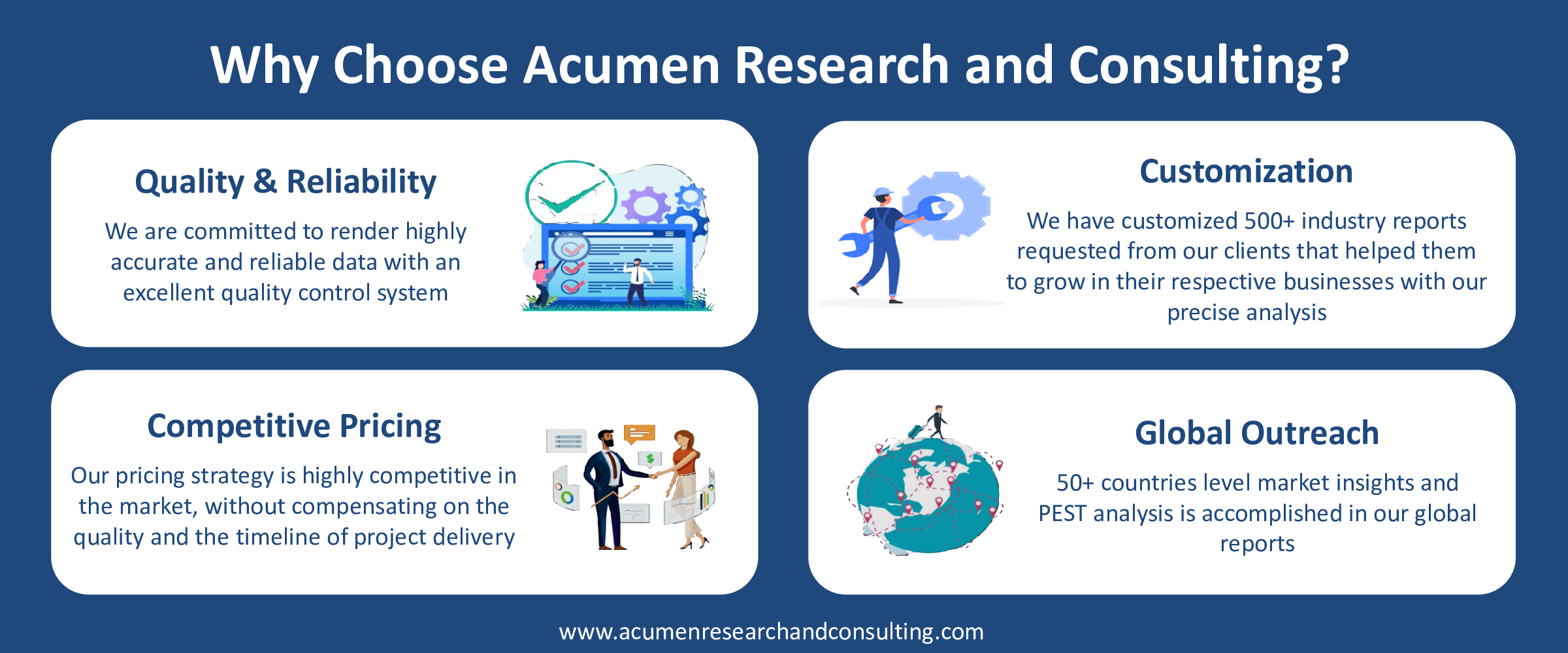Automotive Human Machine Interface Market Size - Global Industry, Share, Analysis, Trends and Forecast 2022 � 2030
Published :
Report ID:
Pages :
Format :
Automotive Human Machine Interface Market Size - Global Industry, Share, Analysis, Trends and Forecast 2022 � 2030
Report Coverage
- Industry Dynamics
- Market Size and Forecast Data
- Segment Analysis
- Competitive Landscape
- Regional Analysis with a Niche Focus on Country-Level Data
- High Level Analysis - Porter's, PESTEL, Value Chain, etc.
- Company Profiles of Key Players
- Option to Customize the Report As Per Your Specific Need
Request Sample Report
The Global Automotive Human Machine Interface Market Size accounted for USD 17.1 Billion in 2021 and is projected to achieve a market size of USD 48.3 Billion by 2030 rising at a CAGR of 12.4% from 2022 to 2030. Growing concerns over driver safety is a primary aspect that is fueling the global automotive human machine interface (HMI) market growth. In addition to that, the rising technological advancements in automotive sector is a very popular automotive HMI market trend that is driving the industry demand.

Automotive Human Machine Interface Market Report Statistics
- Global automotive human machine interface market revenue is estimated to reach USD 48.3 Billion by 2030 with a CAGR of 12.4% from 2022 to 2030
- Asia-Pacific automotive human machine interface market share accounted for over 36% shares in 2021
- According to a recent statistics, automotive sales in China valued for 26.3 million units in 2021, up by 4% from last year
- North America automotive human machine interface market growth will record significant CAGR from 2022 to 2030
- Based on product type, instrument cluster covered for over 40% of the overall market share in 2021
- Rising number of road accidents primarily fuels the global automotive human machine interface market value
A Human Machine Interface (HMI) is software that displays information about the state of a process to a client, accepts commands, and executes the operator's control directions. Typically, information in HMI is displayed in a lifelike format or via a graphical user interface. As HMI becomes more prevalent in the automobile industry, new vehicles are being designed with more sophisticated safety features, and the driver-vehicle relationship is evolving.
Global Automotive Human Machine Interface Market Dynamics
Market Drivers
- Increase in connected vehicles
- Low cost of HMI enabling software
- Growth in mobility services
- Surging preference for enhanced safety and convenience features
Market Restraints
- Rising concerns over cyber security
- High power consumption
Market Opportunities
- Increasing sales of electric vehicles
- Growing demand for autonomous vehicles
Automotive Human Machine Interface Market Report Coverage
| Market | Automotive Human Machine Interface Market |
| Automotive Human Machine Interface Market Size 2021 | USD 17.1 Billion |
| Automotive Human Machine Interface Market Forecast 2030 | USD 48.3 Billion |
| Automotive Human Machine Interface Market CAGR During 2022 - 2030 | 12.4% |
| Automotive Human Machine Interface Market Analysis Period | 2018 - 2030 |
| Automotive Human Machine Interface Market Base Year | 2021 |
| Automotive Human Machine Interface Market Forecast Data | 2022 - 2030 |
| Segments Covered | By Product Type, By Interface Type, By Vehicle Type, By Access Type, And By Geography |
| Regional Scope | North America, Europe, Asia Pacific, Latin America, and Middle East & Africa |
| Key Companies Profiled | Aptiv plc, Alpine Electronics Inc., Bosch Inc., Clarion Co., Ltd., Continental AG, Denso Corporation, Magneti Marelli S.p.A, Samsung Electronics Co. Ltd, Synaptics, Valeo, and Visteon Corporation. |
| Report Coverage |
Market Trends, Drivers, Restraints, Competitive Analysis, Player Profiling, Regulation Analysis |
Automotive Human Machine Interface Market Dynamics
Market Trend
Application for voice interaction in automotive human machine interface market
In automotive HMI design, the essence of human machine interaction is information transmission and processing. In the future, automotive HMI design will be scenario-based, taking into account the application and cooperation of various interactive channels. In the task control process, one interactive channel can be used as the main channel, combining with another interactive channel, such as voice gesture or voice button, to fully exploit the interactive advantages of both channels and smoothly complete the discrete and continuous control tasks. Despite the fact that there has been a significant amount of research on the application of intelligent voice operation, the majority of studies are still focusing on the hardware solution of voice interaction, resulting in a lack of a clear design method and systematic framework of the voice interaction based automotive HMI. A good voice interactive product should be versatile; the more domains it can cover, the better its skills.
Market Drivers
The factors driving the growth of the automotive HMI market include an increase in demand for connected cars, a focus on technological advancement among automotive manufacturers, and increased sales of passenger and commercial vehicles. The growing demand for connected cars will drive up the demand for HMI in vehicles. The connected car is a self-contained unit that communicates and interacts with other devices. The use of HMI in the car will enable the vehicle and its occupants to interact more smoothly. The user can access various vehicle controls via standard or multimodal HMI. The automotive industry is working to develop a technology that will result in a larger market share. The integration of smart phones with HMI, increased safety features, gesture and voice recognition for enhanced HMI, and its widespread use in autonomous vehicles are the key trends in the automotive HMI market. The trend of automotive HMI will result in market growth in the future. In addition, increased sales of passenger and commercial vehicles in emerging markets will increase demand for HMI in vehicles.
COVID-19 impact on the global automotive human machine interface market
The worldwide lockdown imposed to protect people from being severely harmed by the Corona virus is coming to an end, and corporations plan to resume operations. It will take a fortnight of planning to launch business operations. The pandemic had an unexpected and severe impact on the globally integrated automotive industry. The consequences include delays in the shipment of Chinese automotive parts, large-scale manufacturing delays across Europe, and the closure of numerous equipment plants in the United States. This is putting serious strain on the automotive human-machine interface market, which is already dealing with a drop in global demand and is likely to abandon merger and acquisition activity.
Automotive Human Machine Interface Market Segmentation
The worldwide automotive human machine interface market is split based on product type, interface type, vehicle type, access type, and geography.
Automotive Human Machine Interface Market By Product Type
- Instrument Cluster
- Multifunctional Switches
- Steering Mounted Controls
- Central Display
- Rear Seat Entertainment Display
- Head-up Display
According to our automotive human machine interface industry analysis, the Instrument clusters are expected to have a significant market share in the coming years, based on product type. A growing trend among automotive manufacturers to develop fully digital and 3D clusters is expected to support the global automotive human machine interface market growth.
Automotive Human Machine Interface Market By Interface Type
- Visual
- Acoustic
- Mechanical

As per automotive human machine interface market forecast, visual interfaces are expected to dominate the global automotive human machine interface market by interface type. There is a growing trend among market players to develop innovative display systems, as well as an increase in the use of touch-screen display panels in middle and lower segment passenger cars. This is one of the most important factors influencing global market growth.
Automotive Human Machine Interface Market By Vehicle Type
- Passenger Vehicle
- Commercial Vehicle

In 2021, passenger vehicles account for a sizable share of the global automotive human machine interface market. The rising global production of passenger vehicles, combined with rapid technological advancements in HMI systems aimed at the passenger vehicle segment, is expected to fuel market growth over the forecast period.
Automotive Human Machine Interface Market By Access Type
- Standard Interface
- Multimodal Interface
The multimodal interface market dominates the global access type market. The rapid market expansion can be attributed to the growing trend of developing multimodal interfaces to incorporate haptic and acoustic interaction capabilities into HMI systems. Multi-modal input methods such as gesture control, voice control, touch screen, and haptic feedback are replacing traditional interface components such as hard push buttons, rotary controls, and warning lights.
Automotive Human Machine Interface Market Regional Outlook
North America
- U.S.
- Canada
Europe
- U.K.
- Germany
- France
- Spain
- Rest of Europe
Latin America
- Mexico
- Brazil
- Rest of Latin America
Asia-Pacific
- India
- Japan
- China
- Australia
- South Korea
- Rest of Asia-Pacific
The Middle East & Africa (MEA)
- Gulf Cooperation Council (GCC)
- South Africa
- Rest of the Middle East & Africa
Automotive Human Machine Interface Market Regional Analysis
Asia-Pacific Dominates the Global Automotive Human-Machine Interface Market
The rapid expansion of the automotive industry in countries such as China, India, Japan, and South Korea is a major factor driving the Asia Pacific automotive human-machine interface market. Increased vehicle sales, ongoing developments in connected vehicle technologies, and favorable changes in vehicle safety regulations are driving demand for automotive HMI systems in Asia Pacific. Furthermore, due to lower costs, Asia Pacific countries such as China and Japan are becoming manufacturing hubs for automakers. Additionally, increased disposable income will result in increased vehicle sales. As a result, there will be a greater demand for HMI in vehicles.
North America, on the other hand, is expected to have the fastest growth in the automotive human machine interface market. The increased sale of luxury cars will also result in a higher installation of HMI in the car, resulting in market growth. The US is expected to dominate the market in North America in the future.
Automotive Human Machine Interface Market Players
Some of the key automotive human machine interface companies in the market are Aptiv plc, Alpine Electronics Inc., Bosch Inc., Clarion Co., Ltd., Continental AG, Denso Corporation, Magneti Marelli S.p.A, Samsung Electronics Co. Ltd, Synaptics, Valeo, and Visteon Corporation.
Frequently Asked Questions
What is the size of global automotive human machine interface market in 2021?
The market size of automotive human machine interface market in 2021 was accounted to be USD 17.1 Billion.
What is the CAGR of global automotive human machine interface market during forecast period of 2022 to 2030?
The projected CAGR of automotive human machine interface market during the analysis period of 2022 to 2030 is 12.4%.
Which are the key players operating in the market?
The prominent players of the global automotive human machine interface market are Aptiv plc, Alpine Electronics Inc., Bosch Inc., Clarion Co., Ltd., Continental AG, Denso Corporation, Magneti Marelli S.p.A, Samsung Electronics Co. Ltd, Synaptics, Valeo, and Visteon Corporation.
Which region held the dominating position in the global automotive human machine interface market?
Asia-Pacific held the dominating automotive human machine interface during the analysis period of 2022 to 2030.
Which region registered the fastest growing CAGR for the forecast period of 2022 to 2030?
North America region exhibited fastest growing CAGR for automotive human machine interface during the analysis period of 2022 to 2030.
What are the current trends and dynamics in the global automotive human machine interface market?
Increase in connected vehicles, low cost of HMI enabling software, and growth in mobility services drives the growth of global automotive human machine interface market.
Which product type held the maximum share in 2021?
Based on product type, instrument cluster segment is expected to hold the maximum share automotive human machine interface market.



